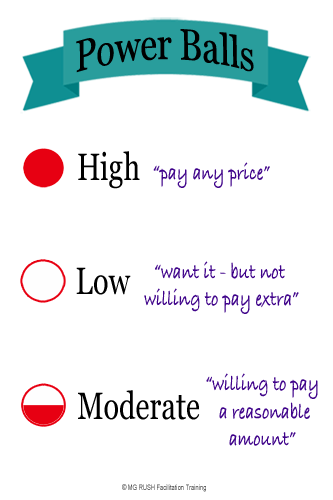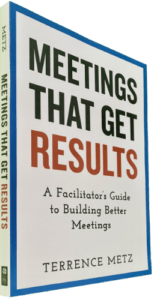In managing capital projects or leading teams, facilitators often grapple with prioritization, where every item can feel equally important. However, allowing everything to be “most important” dilutes focus and slows down decision-making. This is where our Bookend method and accompanying rhetorical techniques come into play, offering a strategic solution to rank priorities efficiently and meaningfully.
Why the Bookend Method Works
The primary challenge with traditional, linear approaches to prioritization is that they encourage discussions around gray areas—those items that fall into moderate categories (e.g., “moderately important,” “reasonable cost”). Unfortunately, these middle-ground discussions often lead to drawn-out debates that add little to decision quality.
Instead, experience shows that extreme criteria—the highest and lowest importance factors—drive impactful decision-making. By focusing on these extremes, the Bookend method bypasses fruitless arguments and identifies the most crucial factors first.
The Problem with Traditional Prioritization
Untrained facilitators often begin with a linear approach, asking whether an item is high, medium, or low in importance. The result? Most items end up in the “high” category, diluting the overall value of the list. While each item on the list may indeed be important, the method fails to differentiate clearly between them.
By using the Bookend method, facilitators avoid these pitfalls and achieve better balance across categories. PowerBallls make this easy as demonstrated below.
How the Bookend Method Works
- Identify the Extremes: Start by asking, “Which item is the most important?” and mark it using the filled circle PowerBall icon. Then ask, “Which is the least important?” and mark it with the empty circle PowerBall icon.
- Work Toward the Middle: Repeat the process, alternating between the next most important and least important items, until two-thirds of the list is scored.
- Address the Middle: For the remaining one-third, ask the group, “Will you lose any sleep over categorizing these as moderate?”
- Consistent Language: Always ask in singular terms—“which is”—to focus discussions. Be ready to take multiple inputs if participants speak simultaneously.
- Bucket Distribution: Divide the total list into three categories (high, moderate, low) while ensuring balance. If necessary, adjust by adding or removing an item from a category, maintaining overall distribution.
- Force-Ranking Alternative: For a more granular ranking, apply the highest available number for the most important, the lowest for the least important, and alternate until all items are ranked.
Use Cases and Flexibility
When comparing illustrations or scenarios, ask questions like:
- Which is most similar?
- Which is least similar?
Repeat the process until one-third of the items remain uncategorized, placing them in the moderate bucket.
For discussions around personal or group strengths and weaknesses:
- What is your greatest strength?
- What is your greatest weakness?
Again, repeat this process until the list is reduced to one-third, placing the remainder into the moderate category.
We discourage overly complex breakdowns (e.g., one-quarter or three-quarter categories) unless they help avoid unnecessary debates. Flexibility is key—apply this method pragmatically to keep the group focused on progress, not arguments.
Numeric Alternative (Six Levels)
For more complex scenarios where finer gradations are needed, consider this six-level system:
- Low Importance
- Moderately Low Importance (if needed)
- Moderate Importance
- Moderately High Importance (if needed)
- High Importance
- Null (Will not have)
By guiding groups to focus on extremes and avoid gray areas, the Bookend method enables efficient, impactful decision-making. It saves time, reduces frustration, and enhances the clarity of priorities.

Power Ball poster available in our Facilitation Store at MGRush.com/shop
_____
Don’t ruin your career by hosting bad meetings. Sign up for a workshop or send this to someone who should. MGRUSH workshops focus on meeting design and practice. Our workshops also provide a superb way to earn up to 40 SEUs from the Scrum Alliance, 40 CDUs from IIBA, 40 Continuous Learning Points (CLPs) based on Federal Acquisition Certification Continuous Professional Learning Requirements using Training and Education activities, 40 Professional Development Units (PDUs) from SAVE International, as well as 4.0 CEUs for other professions. (See workshop and Reference Manual descriptions for details.) Take a moment to SHARE this article with others.
In a world where everyone can engage in decisions that affect them,
_____
With Bookmarks no longer a feature in WordPress, we need to append the following for your benefit and reference
- 20 Prioritization Techniques = https://foldingburritos.com/product-prioritization-techniques/
- Creativity Techniques = https://www.mycoted.com/Category:Creativity_Techniques
- Facilitation Training Calendar = https://mgrush.com/public-facilitation-training-calendar/
- Liberating Structures = http://www.liberatingstructures.com/ls-menu
- Management Methods = https://www.valuebasedmanagement.net
- Newseum = https://www.freedomforum.org/todaysfrontpages/
- People Search = https://pudding.cool/2019/05/people-map/
- Project Gutenberg = http://www.gutenberg.org/wiki/Main_Page
- Scrum Events Agendas = https://mgrush.com/blog/scrum-facilitation/
- Speed test = https://www.speedtest.net/result/8715401342
- Teleconference call = https://youtu.be/DYu_bGbZiiQ
- The Size of Space = https://neal.fun/size-of-space/
- Thiagi/ 400 ready-to-use training games = http://thiagi.net/archive/www/games.html
- Visualization methods = http://www.visual-literacy.org/periodic_table/periodic_table.html#
- Walking Gorilla = https://youtu.be/vJG698U2Mvo

Terrence Metz, president of MG RUSH Facilitation Training, was just 22-years-old and working as a Sales Engineer at Honeywell when he recognized a widespread problem—most meetings were ineffective and poorly led, wasting both time and company resources. However, he also observed meetings that worked. What set them apart? A well-prepared leader who structured the session to ensure participants contributed meaningfully and achieved clear outcomes.
Throughout his career, Metz, who earned an MBA from Kellogg (Northwestern University) experienced and also trained in various facilitation techniques. In 2004, he purchased MG RUSH where he shifted his focus toward improving established meeting designs and building a curriculum that would teach others how to lead, facilitate, and structure meetings that drive results. His expertise in training world-class facilitators led to the 2020 publication of Meetings That Get Results: A Guide to Building Better Meetings, a comprehensive resource on effectively building consensus.
Grounded in the principle that “nobody is smarter than everybody,” the book details the why, what, and how of building consensus when making decisions, planning, and solving problems. Along with a Participant’s Guide and supplemental workshops, it supports learning from foundational awareness to professional certification.
Metz’s first book, Change or Die: A Business Process Improvement Manual, tackled the challenges of process optimization. His upcoming book, Catalyst: Facilitating Innovation, focuses on meetings and workshops that don’t simply end when time runs out but conclude with actionable next steps and clear assignments—ensuring progress beyond discussions and ideas.




